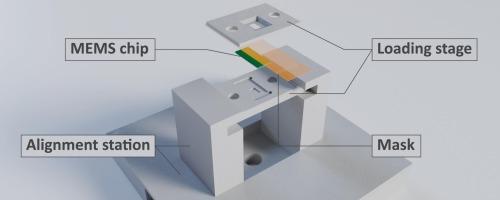Low-cost 3D-printed mask system for versatile selective sample deposition on in situ TEM chips
IF 2.1
Q3 ENGINEERING, ELECTRICAL & ELECTRONIC
引用次数: 0
Abstract
In situ liquid electron microscopy has emerged as a powerful technique for studying dynamic processes at the nanoscale. However, selective deposition of samples on in situ biasing MEMS chips is far from straightforward due to the relatively small area of the electron-transparent window and the compact design of the three electrodes. This is particularly challenging for samples dispersed in solvents or those fabricated through physical vapor deposition. Here, we address these challenges by proposing a simple, low-cost, 3D-printed loading stage with an integrated mask system. Our design enables controlled deposition, as demonstrated by the successful deposition of AuPdPt nanoparticles from liquid suspension, sputtered Au clusters, and a cluster-based Au thin film onto the working electrode. The design can be easily fabricated in any electron microscopy lab, making it accessible and adaptable to various MEMS in situ chips and sample types.

低成本的3d打印掩膜系统,用于多用途的选择性样品沉积在原位TEM芯片上
原位液体电子显微镜已经成为研究纳米尺度动态过程的一种强有力的技术。然而,由于电子透明窗口的面积相对较小以及三个电极的紧凑设计,在原位偏置MEMS芯片上选择性沉积样品远非直截了当。这对于分散在溶剂中的样品或通过物理气相沉积制备的样品尤其具有挑战性。在这里,我们通过提出一个简单的,低成本的,3d打印的装载阶段与集成的掩模系统来解决这些挑战。我们的设计实现了可控的沉积,成功地从液体悬浮液中沉积了AuPdPt纳米颗粒,溅射了金簇,并在工作电极上形成了基于簇的金薄膜。该设计可以在任何电子显微镜实验室中轻松制造,使其易于访问并适应各种MEMS原位芯片和样品类型。
本文章由计算机程序翻译,如有差异,请以英文原文为准。
求助全文
约1分钟内获得全文
求助全文
来源期刊

HardwareX
Engineering-Industrial and Manufacturing Engineering
CiteScore
4.10
自引率
18.20%
发文量
124
审稿时长
24 weeks
期刊介绍:
HardwareX is an open access journal established to promote free and open source designing, building and customizing of scientific infrastructure (hardware). HardwareX aims to recognize researchers for the time and effort in developing scientific infrastructure while providing end-users with sufficient information to replicate and validate the advances presented. HardwareX is open to input from all scientific, technological and medical disciplines. Scientific infrastructure will be interpreted in the broadest sense. Including hardware modifications to existing infrastructure, sensors and tools that perform measurements and other functions outside of the traditional lab setting (such as wearables, air/water quality sensors, and low cost alternatives to existing tools), and the creation of wholly new tools for either standard or novel laboratory tasks. Authors are encouraged to submit hardware developments that address all aspects of science, not only the final measurement, for example, enhancements in sample preparation and handling, user safety, and quality control. The use of distributed digital manufacturing strategies (e.g. 3-D printing) is encouraged. All designs must be submitted under an open hardware license.
 求助内容:
求助内容: 应助结果提醒方式:
应助结果提醒方式:


